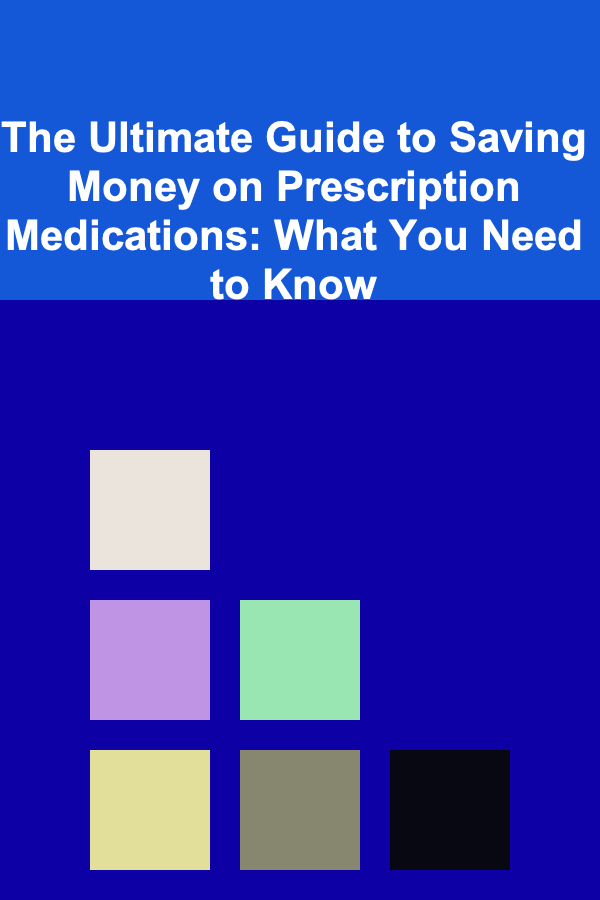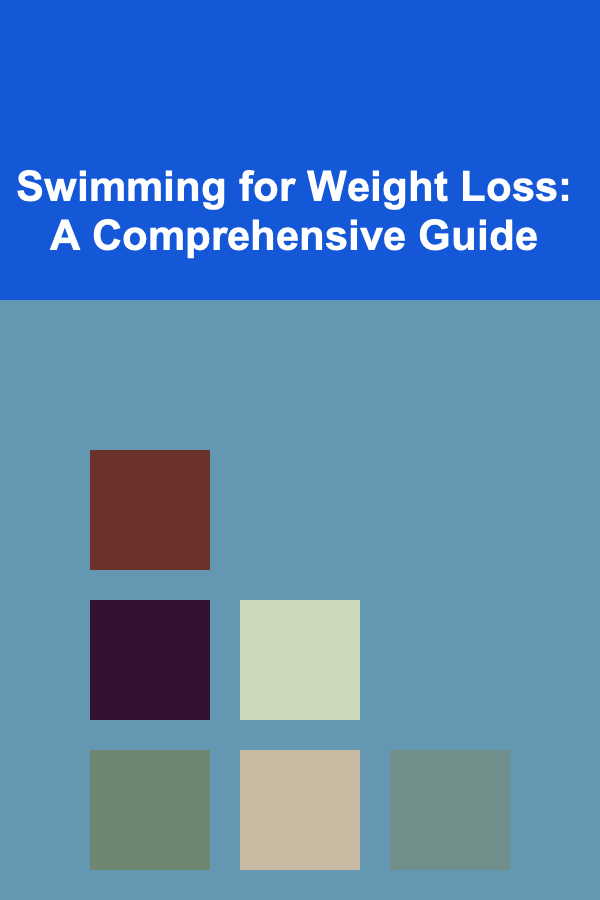
The Ultimate Guide to Saving Money on Prescription Medications: What You Need to Know
ebook include PDF & Audio bundle (Micro Guide)
$12.99$6.99
Limited Time Offer! Order within the next:

Prescription medications can be a significant financial burden, especially for those managing chronic health conditions or needing multiple medications. The costs associated with prescriptions often seem out of control, leading many to wonder if there are ways to lower these expenses. Fortunately, there are numerous strategies available to help you save money on prescription medications without compromising your health. This comprehensive guide will explore actionable steps, practical tips, and resources to help you navigate the often complex world of prescription drug pricing and find savings that work for you.
Understand Your Insurance Coverage
The first step in saving money on prescriptions is understanding your health insurance plan's coverage. Many people overlook the nuances of their insurance benefits, which can lead to unnecessary spending.
Review Your Prescription Drug Plan
Most health insurance plans have a formulary---a list of covered drugs. The medications on this list are often grouped into tiers, and each tier has a different cost. For instance, generics (Tier 1) are generally cheaper than brand-name drugs (Tier 3). Knowing which drugs are covered, their tier, and the associated copayment or coinsurance will give you a clearer idea of how much you will pay out-of-pocket.
Utilize a Prescription Savings Card
Many insurance providers offer prescription savings programs that can help reduce the cost of your medications. Some plans provide prescription discount cards, or there are third-party programs available, which offer savings on medications even if you don't have insurance. It's always worth inquiring about these programs when you fill a prescription.
Appeal Your Insurance Denials
If your insurance plan denies coverage for a medication you need, don't give up. You can file an appeal. Sometimes, insurance companies will approve the medication if they are provided with additional medical documentation that supports its necessity. While this process can be tedious, it can save you significant amounts in the long run.
Shop Around for the Best Price
Pharmacy prices can vary dramatically from one location to another, even for the same medication. That's why it's essential to compare prices and take advantage of different strategies to reduce costs.
Use Pharmacy Price Comparison Tools
Numerous websites and apps, such as GoodRx, RxSaver, and SingleCare, allow you to compare the prices of medications across different pharmacies. These platforms provide you with discount coupons and offer side-by-side comparisons to help you identify the most affordable options in your area.
Check Prices at Local and Chain Pharmacies
Pharmacies within grocery stores, big-box retailers, and discount stores may offer lower prices than independent pharmacies or major chains. For example, some stores like Costco or Walmart offer generic medications at a much lower cost, even for individuals who are not members. It's worth calling ahead or using the price comparison tools mentioned above to check prices across different locations.
Ask About Generic Options
Brand-name medications are typically more expensive than their generic counterparts, but generics are often just as effective. Ask your doctor if a generic version of your prescribed medication is available. Generic drugs contain the same active ingredients and are required to meet the same safety standards as brand-name medications, making them a safe and cost-effective alternative.
Consider Mail-Order Pharmacies
Some mail-order pharmacies offer medications at a lower price than traditional brick-and-mortar stores, especially for long-term prescriptions. If you take maintenance medications, such as those for high blood pressure or diabetes, using a mail-order service could save you money. Additionally, mail-order pharmacies often offer a 90-day supply, which can reduce costs further compared to the standard 30-day refill.
Use Patient Assistance Programs
Many pharmaceutical companies offer patient assistance programs (PAPs) that provide free or discounted medications to individuals who meet certain income and eligibility criteria. These programs are often underutilized but can be a valuable resource for those who struggle to afford their medications.
Research Patient Assistance Programs
Pharmaceutical companies such as Pfizer, Eli Lilly, and Novartis run PAPs that offer medications for free or at a reduced cost. To qualify for assistance, you generally need to meet income requirements, be uninsured or underinsured, and have a prescription from your healthcare provider. Some organizations, like NeedyMeds and Patient Advocate Foundation, can help you find programs specific to your medication.
Talk to Your Doctor
Your healthcare provider can be a valuable ally in obtaining financial assistance. Many doctors are familiar with patient assistance programs and can help you navigate the application process. They may also be able to suggest alternative treatments that are more affordable, should the medication be too expensive.
Check Eligibility for State and Federal Assistance Programs
In addition to pharmaceutical company assistance programs, government programs like Medicaid and Medicare can provide financial relief for eligible individuals. Medicaid, for instance, helps low-income individuals and families access prescription medications at reduced or no cost. Medicare Part D also helps cover prescription costs for seniors, and many states offer supplemental assistance programs for those in need.
Consider Lifestyle Changes and Natural Alternatives
In some cases, lifestyle changes or natural alternatives can help reduce the need for expensive medications. While you should always consult with your healthcare provider before making significant changes to your treatment plan, there are several lifestyle adjustments that could reduce your reliance on prescriptions.
Focus on Prevention
Preventative care is essential for managing chronic conditions and preventing expensive medical treatments down the road. By maintaining a healthy diet, exercising regularly, and managing stress, you may reduce your need for medications to manage conditions such as diabetes, hypertension, or high cholesterol. These lifestyle changes may not completely eliminate the need for medication, but they could reduce the dosage or frequency of prescriptions.
Explore Natural Supplements
Some individuals turn to natural supplements or over-the-counter options as an alternative to prescription medications. Again, it's essential to consult your doctor before switching from prescribed medications to natural remedies. For example, supplements such as omega-3 fatty acids may help lower cholesterol levels, or turmeric may have anti-inflammatory properties. These alternatives may be more affordable, but they should only be used with your doctor's approval.
Take Advantage of Discount Programs and Coupons
In addition to pharmacy price comparison tools, there are many websites and services that offer prescription drug discounts in the form of coupons. These programs can help lower the cost of your medications significantly.
Use Discount Programs like GoodRx and RxSaver
GoodRx, RxSaver, and other prescription discount platforms provide free coupons that can be used at participating pharmacies. By entering your medication's name, dosage, and location, you can get a coupon that may offer significant savings, sometimes up to 80%. These programs are especially helpful for those without insurance or those whose insurance doesn't cover certain medications.
Sign Up for Pharmacy Loyalty Programs
Some pharmacies offer loyalty programs where you can earn points toward discounts on prescriptions, free health screenings, or other perks. While these programs may not provide immediate savings, they can add up over time, especially if you fill prescriptions regularly at the same pharmacy.
Review Your Health Plan Annually
Insurance plans change annually, and the costs associated with prescription medications may vary. It's important to review your health plan each year during open enrollment to ensure that you have the best coverage for your prescription needs.
Evaluate Your Plan's Formulary
Pharmacies and insurance companies may update their formularies, meaning the list of covered drugs can change from year to year. If a medication you need is no longer covered or has moved to a higher tier, you may want to consider switching to a different medication or insurance plan. Be proactive in evaluating the formulary before you renew your health plan.
Consider Switching Insurance Plans
If you find that your current plan isn't meeting your prescription needs, consider shopping around for a different plan during the open enrollment period. Look for plans with lower copayments or ones that offer better coverage for the specific medications you require. Make sure to compare plans carefully, focusing on both premiums and out-of-pocket costs for prescriptions.
Conclusion
Saving money on prescription medications is possible, but it requires a combination of understanding your insurance coverage, shopping smart, exploring assistance programs, and considering alternatives. By employing the strategies outlined in this guide, you can make significant strides in reducing your prescription drug costs while maintaining your health. Whether you choose to compare prices, apply for patient assistance programs, or explore natural alternatives, the key is to take control of your healthcare expenses and make informed choices. The process may take some time and effort, but the financial savings and peace of mind will be well worth it in the long run.
Reading More From Our Other Websites
- [Home Budget Decorating 101] How to Give Your Bathroom a Cheap Makeover: Transform Your Space Without Breaking the Bank
- [Home Party Planning 101] How to Transform Your Home into a Spooktacular Scene with Easy Halloween Party Ideas for Home
- [Home Renovating 101] How to Create a Minimalist Style in Your Home Renovation
- [Home Maintenance 101] How to Prevent Water Damage in Your Home with Regular Maintenance
- [Organization Tip 101] How to Simplify Family Meal Prep for Busy Nights
- [Organization Tip 101] How to Use Companion Herbs to Enhance Your Vegetable Garden
- [Home Storage Solution 101] How to Transform Your Small Office with Functional Storage Ideas
- [Home Budget Decorating 101] How to Mix High and Low-End Decor on a Budget
- [Home Space Saving 101] How to Make Your Small Bathroom Feel Bigger with Smart Storage
- [Home Pet Care 101] How to Set Up a Safe Space for Your Pet

How to Achieve Your Financial Goals While Living Paycheck to Paycheck
Read More
How to Escape the Debt Cycle and Start Building Savings
Read More
How to Set Up a Family-Friendly Home Workout Routine
Read More
How to Use Financial Apps to Stay on Track With Your Goals
Read More
Swimming for Weight Loss: A Comprehensive Guide
Read More
10 Tips for Health Coaches to Motivate Clients with Chronic Illness
Read MoreOther Products

How to Achieve Your Financial Goals While Living Paycheck to Paycheck
Read More
How to Escape the Debt Cycle and Start Building Savings
Read More
How to Set Up a Family-Friendly Home Workout Routine
Read More
How to Use Financial Apps to Stay on Track With Your Goals
Read More
Swimming for Weight Loss: A Comprehensive Guide
Read More